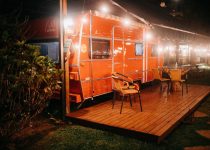How to Make Outdoor Lights Automatic
You can easily make your outdoor lights automatic by using smart technology. Consider installing smart bulbs like Philips Hue for easy control via your smartphone or a Wemo Light Switch that connects to WiFi. For enhanced security, motion-activated lights turn on when they detect movement. Programmable timers, like the Honeywell Econoswitch, allow you to set schedules, optimizing energy use. Remember to follow safety precautions during installation and test the functionality afterward. With various options available, you can find the perfect setup that suits your needs and enhances your home's charm. There's even more to discover about optimizing your lighting experience.
Table of Contents
Key Takeaways
- Install motion-activated lights to automatically illuminate areas when movement is detected, enhancing security and convenience.
- Use smart bulbs with scheduling features to program specific on/off times based on your daily routine.
- Integrate outdoor lighting with presence sensors to activate lights when someone approaches, providing both safety and a warm welcome.
- Utilize a Honeywell Econoswitch to automate outdoor lighting with up to seven programmable settings without needing smart home integration.
- Ensure a neutral wire is present for smart switches to function properly; consult an electrician if unsure about wiring requirements.
Product Options for Automation
When it comes to automating your outdoor lights, you've got several product options that can fit your needs. The Wemo Light Switch is an excellent choice, as it connects directly to WiFi and works seamlessly with Alexa and Google Assistant. This lets you control your outdoor lights remotely through a mobile app, making smart lighting simple and efficient.
If you're looking for flexibility, consider using smart bulbs like Philips Hue or Feit's HomeBrite. These weather-resistant options are perfect for outdoor use and integrate easily with your home network, allowing you to manage your lighting right from your smartphone.
For enhanced security, motion-activated lights from brands like Ring and Philips Hue automatically turn on when they detect movement. This feature not only illuminates your outdoor areas but also adds an extra layer of safety.
Lastly, the Honeywell Econoswitch is a great option for those who prefer programmable schedules without smart home integration. It supports up to seven settings for daily use, allowing you to automate your outdoor lights based on your routine.
With all these options, you can easily find the perfect solution for your outdoor lighting needs.
Installation Considerations
Installing automatic outdoor lights requires careful planning and attention to detail.
First, check that your home has a neutral wire available, as all smart switches need this for proper functionality. If you don't have one, you might need to consult a licensed electrician to help with the installation.
Follow the manufacturer's installation instructions closely, as wiring configurations can differ by product and home wiring standards. It's crucial to ensure you're adhering to the specific guidelines provided.
Before you start, always turn off the power at the circuit breaker to keep yourself safe during installation.
Using the right tools and techniques is vital; if you're unsure about handling electrical wiring, don't hesitate to call a licensed electrician for assistance. This won't only help you avoid potential hazards but also ensure that the installation is done correctly.
Once you've completed the installation, test the functionality of your lights. Confirm they operate correctly and respond to your automation settings as intended.
Taking these precautions will help ensure your outdoor lighting system works efficiently and safely.
Benefits of Smart Lighting
Embrace the numerous benefits of smart lighting to elevate your outdoor spaces. With smart lights, you can enhance security by ensuring your outside lights automatically turn on when you enter or leave your property. This consistent illumination not only deters intruders but also makes your late-night arrivals much safer.
Moreover, these systems can help reduce energy consumption. By utilizing programmable schedules and sensors, your lights adjust usage based on occupancy and time of day, saving you money on electricity bills.
The convenience of controlling your outdoor lights remotely via mobile apps means you can manage them from anywhere, enhancing both safety and ease of use.
Integrating smart lighting with voice assistants like Alexa and Google Assistant adds an extra layer of convenience. You can easily control your outside lights hands-free, streamlining your daily routines.
Additionally, customizing lighting scenes and schedules not only enhances the aesthetics of your outdoor areas but can also boost your home's value. By showcasing advanced technology features, you create a more appealing environment for potential buyers.
Embrace smart lighting, and enjoy a blend of security, efficiency, and style in your outdoor spaces.
Advanced Automation Techniques
Automating your outdoor lights can transform your home's exterior into a responsive, intelligent space.
With advanced automation techniques, you can enhance convenience, security, and aesthetics.
Here are four effective methods to consider:
- Presence Sensors: Use these to turn the lights on automatically when you or a family member approaches your home. This provides an extra layer of security and a warm welcome.
- Timers and Scheduling: Set specific times for your outdoor lights to turn on and off. This ensures your lights are only on when needed, optimizing energy usage while keeping your home safe.
- Seasonal Lighting Scenes: Program your smart home system to adjust outdoor lighting aesthetics throughout the year. This adds a decorative touch and keeps your space looking fresh.
- Integration with Other Smart Devices: Combine outdoor lights with security cameras or motion detectors to create a cohesive smart home experience.
This advanced automation not only enhances safety but also simplifies your daily routine.
Maintenance and Reliability
How can you ensure your outdoor lighting system remains reliable and effective? Regular maintenance is crucial.
Start by cleaning photocells and checking that all connections are secure; this simple step can greatly enhance reliability and prolong the lifespan of your fixtures.
Remember, photocells and motion sensors can wear out over time, so schedule periodic checks and be ready to replace them if needed.
Invest in high-quality, weather-rated fixtures to improve the durability of your outdoor lighting. These fixtures are designed to withstand various environmental conditions, ensuring they function optimally.
Additionally, consider employing manual overrides for your automatic systems. This gives you control, allowing you to address any reliability issues without completely depending on automation.
Lastly, if you're dealing with complex wiring installations, it's wise to consult with an electrician. They can ensure everything is set up safely and reliably, especially if you're integrating multiple automated solutions.
Frequently Asked Questions
Can I Make My Outdoor Lights Motion Activated?
Yes, you can make your outdoor lights motion activated. Choose compatible motion sensors, install them at the right height, and adjust sensitivity settings. This'll enhance security by turning on lights when movement's detected nearby.
Is There a Way to Put Outside Lights on a Timer?
Yes, you can put outside lights on a timer. Consider using a programmable timer switch, smart light switch, or standalone timer device. These options let you easily control when your lights turn on and off automatically.
How to Make Outdoor Lights Dusk to Dawn?
To make outdoor lights dusk-to-dawn, you'll need a photo sensor that detects light levels. Install a screw-in lamp with a built-in sensor or wire a standalone sensor to your existing light fixtures for convenience.
How to Make a Porch Light Smart?
To make your porch light smart, consider installing a Wemo Light Switch for WiFi control, or a GE Z-Wave Light Switch for integration with other devices. Ensure you've got a neutral wire before starting the installation.



